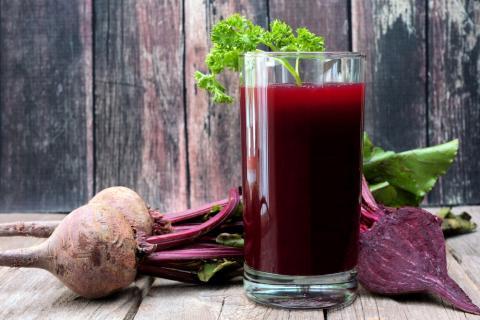
I thought I was up to date on probiotic-packed fermented products, but it turns out I was missing one very old, and very important tonic: beet kvass. I was first introduced to this powerful beverage sometime last year, when a stall at the local farmer’s market I frequent suggested I try their homemade kvass.
“You mean kefir?” I attempted to correct the man. “Or maybe kombucha?” He shook his head.
“No,” he said. “Kvass. Beet kvass.”
The man unscrewed the lid of a glass jar filled with deep, red liquid that bubbled near the top. He poured me a small glass.
“You might not like it at first, but believe me, it’s powerful enough that you’ll want to eventually,” he said.
Strangely, I liked my first taste: earthy, salty, and certainly powerful. The probiotic-goodness of kvass is reminiscent of the carbonation of kombucha but with the salty richness of sauerkraut. Doesn’t sound appetizing? Here are 4 reasons why you need to try this traditional drink.
1. It’s Probiotic
Traditionally, kvass is an eastern European drink originally made from sourdough rye bread. Today it’s more common to find beet kvass, made using fresh beets. Beets are lacto-fermented as the sugar and starch of the beets and sea salt produce lactic acid–which ultimately preserves the kvass. The end result is the blood red tonic I like to drink (and hopefully you will, too.)
2. It’s Highly Beneficial
Beet kvass is overflowing with nutrients. The holistic magazine Mother Earth News reported that it fights inflammation, boosts stamina, aids in regulation, eases digestive problems, improve blood circulation, alkalizes blood, and is a powerful liver cleanser.
3. It Packs a Punch (of Nutrients)
Beets are potent unto themselves, but kvass has a host of nutrients to offer, as well. This website gives a rundown of the available nutrients in a 10 oz. serving, though most suggest that a daily serving of 4 oz. is enough to give you all the benefits you need. Specifically, kvass is high in manganese, vitamin C (which makes it a great immune booster), and B vitamin folate (necessary for pregnant woman.)
4. It’s the Original Sports Drink
Think you need a sports drink to provide the necessary electrolytes and hydration during or after a sports game? Or maybe you’ve been told to put electrolyte powder or other hydration products in your water bottles during long runs. The truth is, kvass is a better hydrator (and electrolyte provider) than any commercial product. Kvass works as a great hydrator because of the electrolytes it contains thanks to salt and the fermentation process. Try taking a 4 oz shot of kvass shortly before a workout. You’ll likely notice a big difference.
To be honest, before writing this article I had never made my own beet kvass. What better time to try it than now? Several recipes online call for the use of whey or another fermentation starter, but I would argue that beet kvass can be made even easier. I used Holistic Squid’s recipe for beet kvass as inspiration for my own recipe.
Recipe: Make Your Own Kvass, ‘kay?
3 large red organic beets
1 teaspoon salt
Filtered or spring water
1 quart jar with lid
- Lightly wash your beets to remove debris and dirt, but do not peel. You’re relying on beneficial bacteria to start your fermentation process and need all the help you can get!
- Cut beets into 1-2 inch squares, then place in a clean quart jar.
- Add 1 teaspoon salt*
- Fill the remaining space with filtered or spring water then tightly close. Several recipes recommend using a jar with an airlock.
- Leave the jar in an undisturbed space away from light/sun for 1-2 weeks, but do check the jar everyday by unscrewing the lid if you are not using an airlock. Pressure can build up, much like you would happen when making kombucha.
- Bottle your kvass and place in fridge. Sometimes the kvass will taste best at least 3 days after being place in the fridge. You can choose to include the bits of beet in the bottled kvass itself or strain the liquid to use the beets in a salad, or roasted with walnuts and topped with goat cheese for a delicious side dish.
*Try your first batch, but be open to adjusting the amount of salt. Some prefer a stronger, saltier brine, whereas others finds a savory taste unpalatable. Experiment to create a drink that you’ll actually want to drink (and will therefore actually get the benefits.)
Several recipes online use various ingredients to flavor and alter the taste of their kvass. For those who prefer a less earthy taste, try adding a fresh herb once bottled, or even berries like strawberries. No matter what, you really can’t go wrong with this delicious and healthful beverage!








